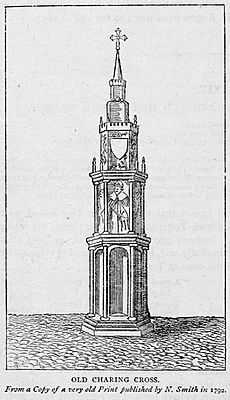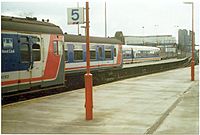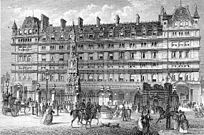Charing Cross facts for kids
Quick facts for kids Charing Cross |
|
|---|---|
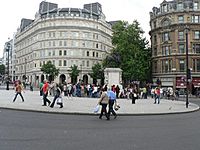 Charing Cross roundabout, with a Statue of Charles I on the site of the original Eleanor Cross in the then hamlet of Charing, an important junction since the middle ages. |
|
| OS grid reference | TQ302804 |
| London borough | |
| Ceremonial county | Greater London |
| Region | |
| Country | England |
| Sovereign state | United Kingdom |
| Post town | LONDON |
| Postcode district | WC2 |
| Dialling code | 020 |
| Police | Metropolitan |
| Fire | London |
| Ambulance | London |
| EU Parliament | London |
| UK Parliament |
|
| London Assembly | |
Charing Cross (/ˈtʃærɪŋ/ CHARR-ing) is a very important road junction in Westminster, London, England. It's where six different roads meet! Since the early 1800s, Charing Cross has been known as the "centre of London". This means it's the official starting point for measuring distances from London to other places.
Imagine a clock: starting from the north, the roads that meet here are:
- The east side of Trafalgar Square, leading to St Martin's Place and then Charing Cross Road.
- The Strand, which goes towards the City.
- Northumberland Avenue, leading to the Thames Embankment.
- Whitehall, which takes you to Parliament Square.
- The Mall, leading to Admiralty Arch and Buckingham Palace.
- Two short roads that lead to Pall Mall.
Long ago, this area was a small village called Charing. This name came from an old English word meaning 'river bend', because of a bend in the River Thames. The "Cross" part of the name comes from a beautiful old monument called the Eleanor cross. This cross stood here for many centuries.
Today, you can see a tall, fancy memorial cross in front of Charing Cross railway station. It was built in 1864 to look like the original cross, but it's much bigger and more detailed. Also, a bronze statue of King Charles I on a horse stands near where the original cross used to be. This statue was put up in 1675.
Contents
Charing Cross: A Historic London Spot
The Name and the Cross
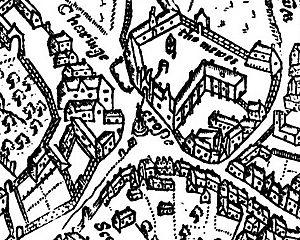
The name "Charing" comes from the Old English word cierring, which means a bend in a river, referring to the River Thames. Some people used to think the name came from the French words chère reine ("dear queen"), but the name was used long before Queen Eleanor died.
The "Cross" part of the name refers to the Eleanor cross. This stone cross was built between 1291 and 1294 by King Edward I. It was a special memorial to his wife, Eleanor of Castile, after she passed away. This cross was the largest and most beautiful of a series of crosses built along the route where her body was taken from Lincoln to London.
The original cross was destroyed in 1647 during the English Civil War. About 200 years later, in 1865, a new stone sculpture was built in front of Charing Cross railway station. This new cross is a Victorian-era version of the medieval cross. It's much taller, about 70 feet (21 metres) high, and very ornate. It stands about 203 metres (222 yards) away from where the original cross was.
Since 1675, the spot where the original cross stood has been marked by a statue of King Charles I on a horse. This king was beheaded during the time of Oliver Cromwell. This statue is now considered the official centre of London for measuring distances.
A Rebellion and a Famous Inn
In 1554, Charing Cross was the site of an important event during Wyatt's Rebellion. This was when Thomas Wyatt tried to overthrow Queen Mary I of England. Wyatt's army marched to Charing Cross, where they faced the Queen's defenders. The rebels eventually surrendered, and the rebellion ended.
For many centuries, a famous coaching inn called the "Golden Cross" stood near this junction. Coaches would leave from here to many cities like Dover, Brighton, and York. The inn is even mentioned in books by the famous writer Charles Dickens, like The Pickwick Papers. Dickens described how dangerous the low archway to the inn's yard was for people sitting on top of the coaches!
The old inn and its yard were later removed to make way for Trafalgar Square. A new Golden Cross Hotel was built nearby in the 1830s.
The Cross Returns
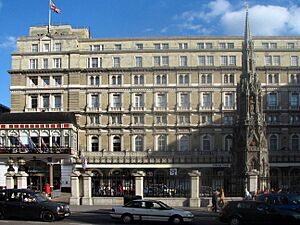
The Charing Cross railway station opened in 1864. To celebrate this, a new, grander version of the Eleanor Cross was built in 1865. This new cross is a beautiful example of Gothic architecture from the Victorian era. It's 70 feet (21 metres) tall and has shields and statues of Queen Eleanor. This cross is now a protected historical monument.
The rebuilding of the cross was part of a movement in Victorian Britain to bring back medieval styles and traditions. The cross gave its name to many things in the area, including the railway station, a tube station, a hospital, a hotel, and a theatre. Charing Cross Road, a major street, was also named after the railway station.
Charing Cross: London's Official Centre
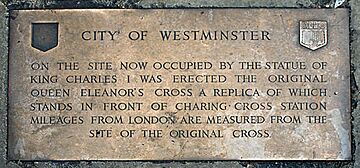
By the late 1700s, people started to see Charing Cross as the true "centre" of London, even more so than the older City. From the early 1800s, many laws and rules for London used Charing Cross as the central point to define their area.
Here are some examples of how Charing Cross has been used as a central point:
| Use | What it meant |
|---|---|
| Hackney carriage (London taxi) licensing | The rules for London's famous black cabs, including how far they must take a fare, are based on a six-mile radius from Charing Cross. |
| Metropolitan Police District | When the Metropolitan Police Act 1829 was created, it said that areas within 12 miles of Charing Cross could be included in the police district. This was later expanded to 15 miles. |
| Building standards | From 1844, building rules and standards applied to buildings within 12 miles of Charing Cross. |
| Street trading | The police had powers to control street trading within six miles of Charing Cross. |
| Amateur radio | Certain radio frequencies are not allowed for amateur radio use within 100 kilometres (62 miles) of Charing Cross. |
Even today, road distances from London are officially measured from Charing Cross. Before this, different places were used, like the General Post Office or various milestones around the city. Using Charing Cross helped make things clearer for travellers.
Neighbouring Locations
 |
Trafalgar Square | Covent Garden | Kingsway |  |
| The Mall | Strand | |||
| Whitehall | London Waterloo via Golden Jubilee Bridges |
South Bank via Waterloo Bridge |
Getting Around Charing Cross
Charing Cross is a major transport hub. The Charing Cross railway station is located on The Strand, just east of the main road junction. If you cross the River Thames using the pedestrian Golden Jubilee Bridges, you can reach Waterloo East and Waterloo stations.
For getting around London by underground train, the nearest stations are Charing Cross and Embankment.
Images for kids
-
Frontage onto Strand/Charing Cross of Northumberland House in 1752 by Canaletto. The statue of Charles I is at the right of the painting.
-
The Pillory at Charing Cross (1809), where people who broke the law were punished publicly. This drawing is by Augustus Pugin and Thomas Rowlandson.
See also
 In Spanish: Charing Cross para niños
In Spanish: Charing Cross para niños



